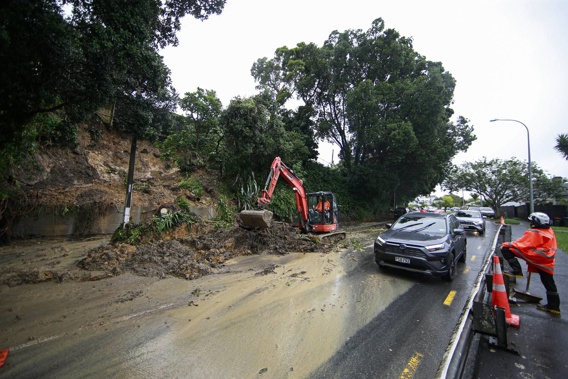
Auckland councillors have voted unanimously today to endorse in principle a $2 billion cost-sharing buyout package for hundreds of uninhabitable properties and other storm-related costs with the Government.
The deal is subject to public consultation over the next two weeks.
It includes the buyout of about 700 Category 3 homes at a cost of $774 million, and $390m towards fixing roads and bridges affected by the Anniversary Weekend storms and Cyclone Gabrielle.
The largest cluster of affected homes is in the West Auckland suburbs of Ranui, Swanson and Henderson andcoastal communities of Piha, Karekare and Muriwai. Other clusters are in Milford and Māngere.
There is also $820m for the council’s Making Space for Water initiative that includes buying properties in flood-prone areas, taking out stormwater pipes and recreating the original streams, culvert and bridge upgrades and overland flow path management.
/cloudfront-ap-southeast-2.images.arcpublishing.com/nzme/N42CAG75ZRFKHMO3JTFPV6LTCA.jpg)
The floods have left a big bill to fix roads. Photo / Alex Burton
Category 3 homes in sites identified for “daylighting streams” will be bought as part of the buyout programme, but the bill for purchasing other properties will be met by the council.
Areas identified for storm resilience include the Wairau Creek on the North Shore, the Waimoko, Opanuku, and Porters streams in West Auckland, Coxs Creek in Grey Lynn, and Harania Creek and Te Ararata Greenway in Māngere.
Mayor Wayne Brown said the agreement was a major step forward.
“The Auckland Anniversary floods and Cyclone Gabrielle had a devastating and lasting impact on many communities, and seven months on, many Aucklanders with damaged homes are still grappling with a challenging future and significant impacts on their mental and social wellbeing.
“While the negotiation process took time, it has resulted in a much better deal for Auckland. This deal will enable us to move faster on our plans to make the region more resilient to future weather events, rolling out the Making Space for Water programme and reinstating a range of transport infrastructure to help our communities return to a sense of normal.
Auckland Mayor Wayne Brown. Photo / Michael Craig
Finance Minister Grant Robertson said $877 million will come from the National Resilience Plan towards Auckland’s recovery from the summer storms.
He said the council had applied for a further $200m for road and other transport repairs, which is being reviewed by Waka Kotahi NZ Transport Agency, bringing the total Crown funding up to $1.1b.
“I am pleased we have reached this agreement so Auckland Council can provide certainty for the people whose properties, or those close to theirs, were severely damaged by landslides or flooding,” Robertson said.
“The Government will contribute up to $387m to support Auckland Council to purchase Category 3 residential properties. This equates to 50 per cent of the net cost, which is the same agreement for Gisborne District Council and Hawke’s Bay councils. The net cost is the agreed buyout value for each property, less any insurance payments the homeowner receives.
The Government is also contributing $380m of the capital cost of the Making Space for Water projects.
Brown said the work to recover and build a more resilient region is expensive, and some of that falls on ratepayers, “so we need to consult with them on those costs”.
It is unclear how the council will value properties, whether it will apply a discount, and how it will treat insured and uninsured properties.
The council may also cap buyouts, which could affect clifftop homes, some of which are worth more than $10 million.
/cloudfront-ap-southeast-2.images.arcpublishing.com/nzme/B5ZSMP3B4JBAJAAAZIPQPPDCEE.jpg)
Finance Minister Grant Robertson. RNZ / Samuel Rillstone
“I have been signalling for some time that we have some major costs coming down the pipe for basic infrastructure. Now more than ever as a council we need to be thinking seriously about how we are going to focus on what matters most and getting value for our spend,” said Brown.
A two-week public consultation on the proposed council-Crown co-funding of storm recovery and affected property buyout will commence mid next month, including targeted local engagement for affected areas.
Subject to the outcome of that process, more decisions will be required by councillors and the mayor on the details of the buy-out scheme and how the council’s share of the costs will be funded.
The Herald understands the council may need to borrow about $600m to meet the costs, leading to rates rising by about 3 per cent over the next two years.
In the meantime, the process to assess and categorise affected properties continues with the council signalling that it would be looking to start direct discussions with homeowners on buyouts towards the end of October.
Bernard Orsman is an Auckland-based reporter who has been covering local government and transport since 1998. He joined the Herald in 1990 and worked in the parliamentary press gallery for six years.
Take your Radio, Podcasts and Music with you

/cloudfront-ap-southeast-2.images.arcpublishing.com/nzme/QFH4T7Q5KNF7XEK7XLYGW67NG4.JPG)








